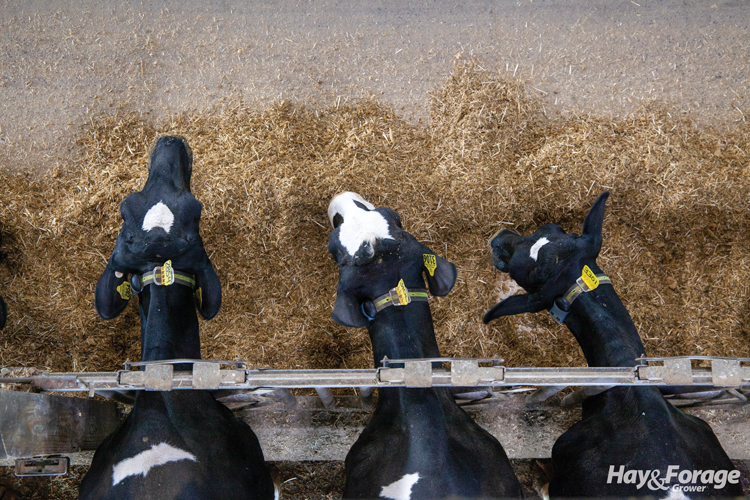
In the face of rising feed prices, dairy producers are seeking opportunities to feed low-cost forages now more than ever. When working with producers to determine options for incorporating different forages into their dairy diets, dry cows and heifers provide a convenient sink for some lower quality forages. It is crucial to emphasize that the term “lower quality” refers to forages characterized by poor fiber digestibility and low nutrient value, not high levels of molds or toxins. Care should be given during harvest and storage to keep the feed clean and free of mold growth.
Establishing the groundwork for a successful lactation begins with ensuring the proper nutrition of dry cows. There are as many ways to feed and manage dry cows as there are dairy farms; however, there are three key features of successful dry cow feeding:
- Avoid overconditioning dry cows
- Promote feed intake during the transition period
- Manage the calcium demands of the fresh period
Lactating dairy cattle have a heightened demand for energy, especially before and around peak lactation, and thus require high-quality forages with limited undigestible fiber. However, the scenario shifts for dry cows, particularly far-off dry cows more than three weeks out from expected calving.
At this point, the emphasis shifts to “filler” forages, with straw being a common example. Filler forages are characterized by low fiber digestion and typically lack significant protein or starch. Their primary function is to provide rumen fill and satiety without contributing excessive energy that could lead to gains in body condition.
Keep an eye on intake
When feeding filler forages to dry cows, keep the second rule of successful dry cow nutrition in mind: Promote feed intake during the transition period. The amount the cow is eating is equally as important as what she is eating out of a total mixed ration (TMR). Like the lactating cow diet, a perfectly balanced dry cow ration loses its efficacy if cows sort through it. Manage feed to minimize sorting to best utilize filler forages in the diet, and ensure cows are able to access the feedbunk at will.
Strategies for minimizing sorting are especially important when using filler forages, including alternative forages, because these lower quality forages will often be stemmy, making it easier for cows to sort around them. Grinding these feeds is typically recommended because they are tougher and may not break down adequately in the wagon during mixing.
Routinely monitor the TMR for long particles in dry cow diets. While less than the width of a cow’s nose is a common rule of thumb for maximum particle length, chopped forages as short as 1 inch can provide sufficient effective fiber while minimizing sorting behavior. Additional techniques to reduce sorting include incorporating liquids like water or molasses into the diet and consistently pushing up feed throughout the day.
Beyond feed management, facilities also impact feed intake by dry cows. Dry cows must always have access to the feedbunk, and animals should not be overstocked, particularly in the last three weeks before calving. Remember that heavily pregnant dry cows require more bunk space. Dry cow facilities must be designed and managed such that cows have cooling, clean bedding and water, and secure footing. Anything introducing a psychological barrier to a cow’s comfort during feeding ultimately hampers her feed intake during this critical period.
Calcium is key
Preventing milk fever by meeting the calcium demands of the fresh period starts before calving. Often, this is accomplished by feeding a negative dietary cation-anion difference (DCAD) in the last three weeks before expected calving. Calculating DCAD is done by adding the major cations (potassium and sodium) and major anions (chloride and sulfur) in the diet and subtracting the anions from the cations. Anions are often incorporated into the diet to achieve a negative value in the equation.
Forages are major contributors of various minerals to the diet, including the ones that are important for managing calcium, such as calcium itself. Potassium in particular is often high in many forages, which will improve the dietary anions that counterbalance dietary cations. Therefore, understanding the mineral contributions of forages is critical for managing calcium around calving.
I had the opportunity to feed switchgrass hay to dry cows through a grant funded by the Ontario Ministry of Food, Agriculture, and Rural Affairs, to study the inclusion of alternative forages into dry cow diets. We compared a TMR with switchgrass hay as the filler forage to a similar dry cow diet that included straw. We ground both the switchgrass hay and the straw to relatively short particle lengths (1 to 2 inches).
Part of the success we had when feeding switchgrass hay was that there was minimal spoilage. Switchgrass hay also had an advantage over straw because it was lower in potassium, making it easier to achieve a negative DCAD.
Taking a broader perspective, switchgrass is cheaper than straw, it can grow on marginal land, and it improves soil health. This example highlights the potential of creative and informed utilization of alternative forages in dry cow diets. By adhering to foundational principles and embracing innovative approaches, dairy farmers can effectively control feed costs while safeguarding cow health and welfare.
This article appeared in the February 2024 issue of Hay & Forage Grower on pages 22-23.
Not a subscriber? Click to get the print magazine.

